The year 2005 nears its end. The United States was embroiled in two wars. In Afghanistan, the Taliban was resurgent. Meanwhile in Iraq, hopes for a withdrawal of U.S. troops were dashed after May which was the bloodiest month since the invasion. Back home, the news media continued to grow more divisive and the American people pushed back against the idea that sacrificing civil liberties was necessary to maintain security.
DMZ #1 was published in November 2005 in the shadow of these events. The series takes place in a vague near future during a second United States civil war. It is unapologetically political, examining a wide array of topics from the military and war profiteering to the media and culture. Surprisingly–or maybe not given how real world events unfolded in subsequent years–the series ran for 72 issues, ending in 2012. And though the series ended 12 years ago, much of DMZ’s commentary remains relevant today. Indeed, some of its world building was almost prescient.
DMZ was written by Brian Wood. Most of the series’ interior art (including these first three issues) was handled by Riccardo Burchielli. Jeromy Cox provided colors for all but one issue. Jared K. Fletcher handled lettering for the series. Wood never pulls punches in his writing. While there are instances of ambiguity that are left to the reader’s interpretation, the series does not shy away from making arguments toward specific conclusions. DMZ still has a lot to say, and it’s worth taking some time to hear it.
The following contains spoilers for DMZ #1-3.
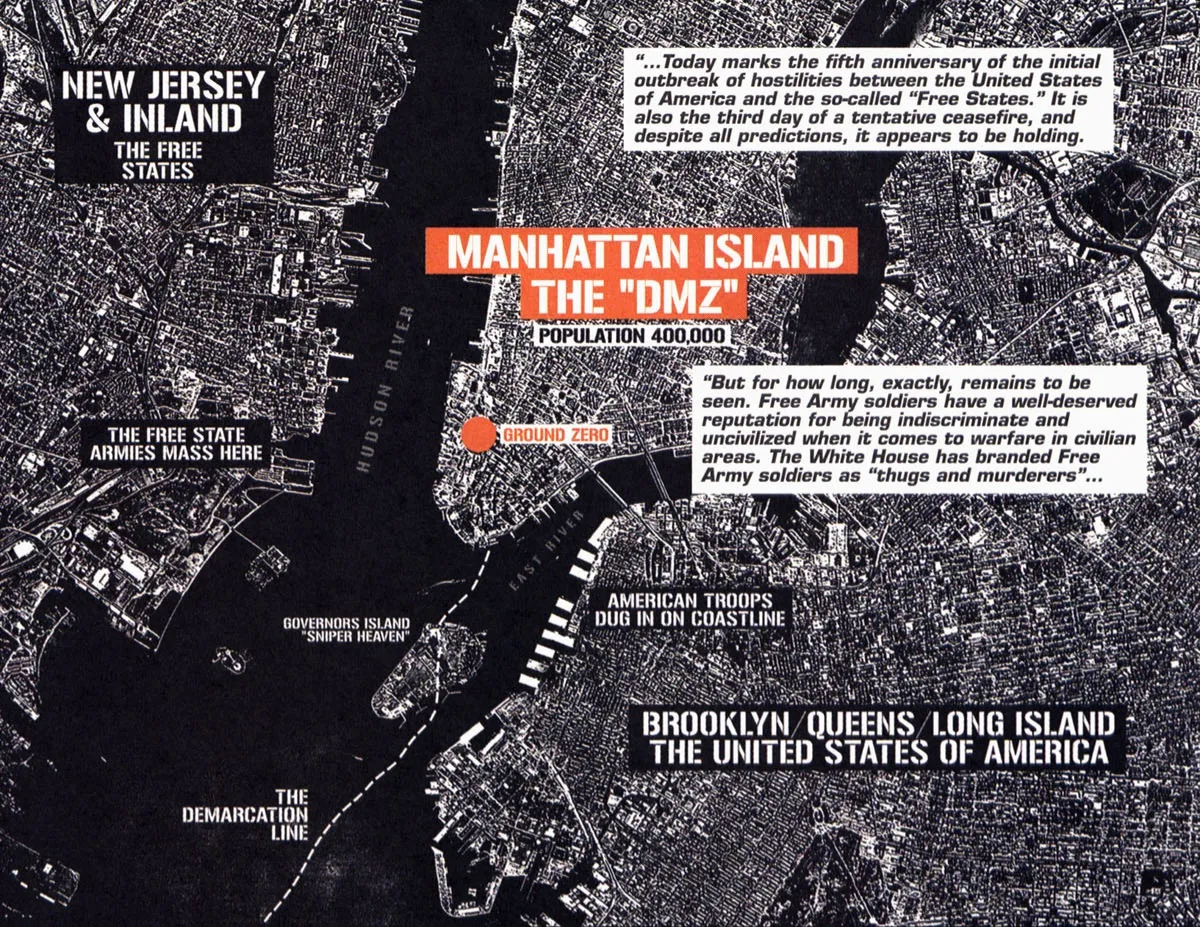
DMZ #1
Rough Landing
DMZ’s first arc, “On the Ground,” opens with a map of the island of Manhattan (labeled The “DMZ”) sandwiched between New Jersey, occupied by the Free States, and the rest of New York, controlled by the United States. Narration in the form of a report from Liberty News establishes that it’s the fifth anniversary of initial hostilities between the United States of America and the “Free States”, there is a ceasefire in place, and a reporter–Nobel Prize winner Viktor Ferguson–is entering Manhattan for the first time since it became a DMZ.
Matty Roth is at Liberty News for a photo tech internship. Instead, as a result of his father pulling some strings, Matty is assigned to Viktor as his photo tech. The DMZ is described as being a place with no security, where rules change neighborhood by neighborhood. Matty is warned to keep his press pass on him at all times to stick close to the security personnel.
As soon as the helicopter sets down in the DMZ, Matty unloads his equipment. Viktor follows. Moments into this, the helicopter and crew come under fire. Viktor climbs back aboard. The helicopter takes off, leaving Matty behind, and explodes seconds later. Matty finds the crash site and the helicopter’s burning wreckage. A woman runs up and holds him at gunpoint immediately after. And then Matty faints.
Matty wakes up some time later, an IV in his arm. The woman, Zee, is the same one that he encountered before he fainted. Zee is a sort of independent medic in the DMZ. She was a med student when the war came to New York. She chose to stay in Manhattan, eventually opening a clinic for the locals and making rounds to patients too sick or wounded to come to her.
Using the cell phone he was issued by Liberty News, Matty makes contact with the network and fills them in on the attack. He’s told he’ll be extracted once the crash site is secured. Matty gives Zee all the medical supplies he has in exchange for her guiding him back to the ruined helicopter. “Securing the crash site” turns out to be a euphemism for bombing it and the immediate area. Matty and Zee are nearly killed.
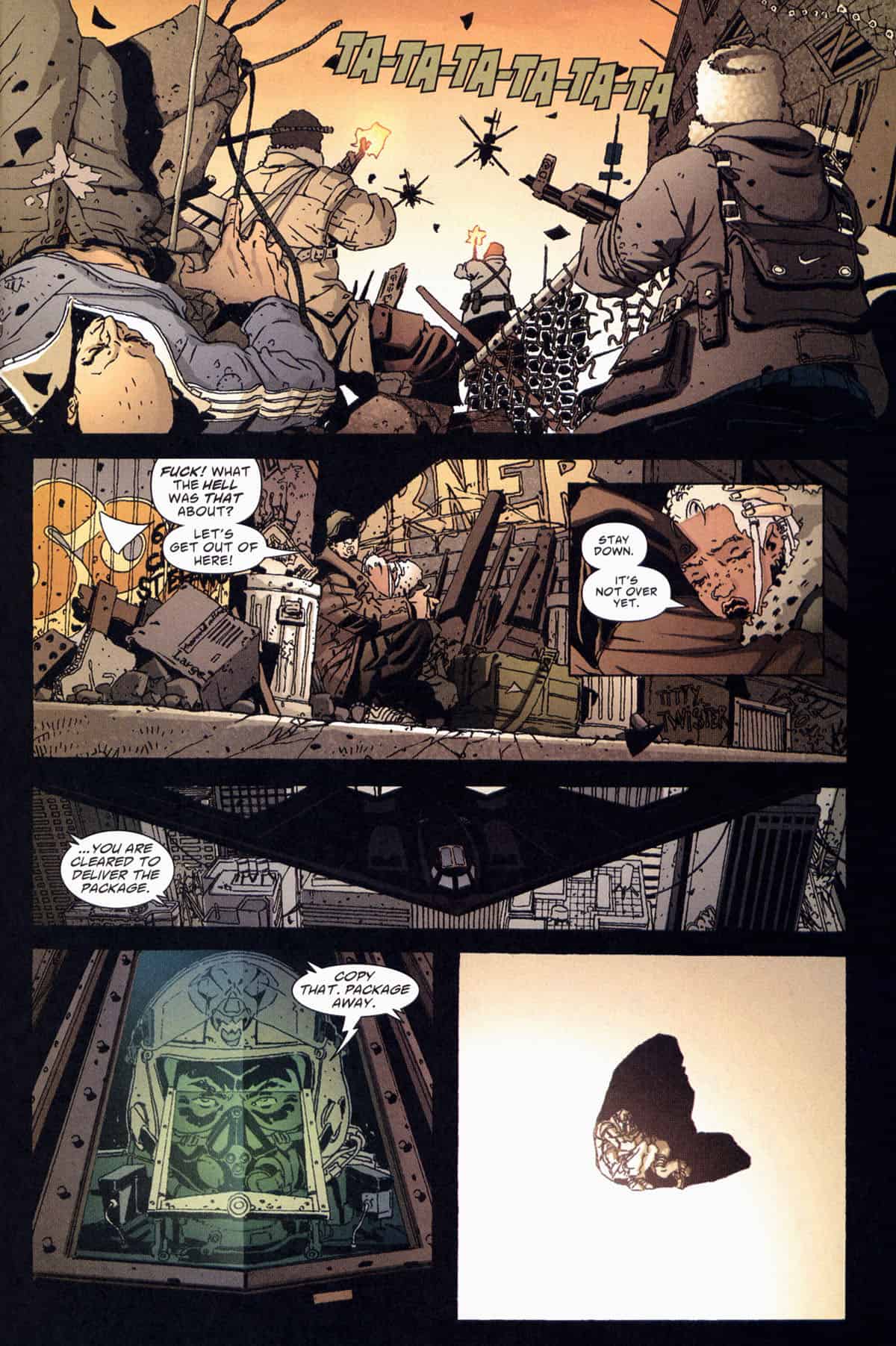
DMZ #1
Ditched by Liberty News with no idea how to survive in the DMZ, Matty accompanies Zee on her rounds the next day. He quickly discovers that the truth of the DMZ is far different from how it’s reported to those beyond its borders. There is a lot of violence, but there is a kind of culture. Zee takes Matty to a rooftop garden with tables for people to sit and eat, Matty is incredulous. Liberty News and other news media report that DMZ residents subsist on rats and other vermin.
Zee and other residents aren’t keen on journalists being in the DMZ and exploiting the people in it for ultimately false stories. But when Zee and Matty discover that one of her friends salvaged Matty’s equipment from the wreckage, Zee insists that Matty is in a position to report on what’s really going on in the DMZ. Matty, though lacking any kind of training or experience in journalism, gives in to the pressure and agrees to give it a try.
Zee agrees to escort Matty through the city to areas that no “tourists” could safely access. As the day goes on, Matty sees the carnage left behind by the fighting in the DMZ (both from residents and from the outside military). But Matty also learns about art studios, homegrown engineering projects, and urban farms among other things. In the course of this tour he meets one of the DMZ’s most colorful characters, a sniper who is AWOL from the United States military. The Sniper keeps the lower Hudson relatively safe from violence. He used to do it via gunfire, but since he ran out of ammo he serves as a kind of neighborhood watch. He’s also in a long distance relationship with a Free States sniper who’s positioned across the river.
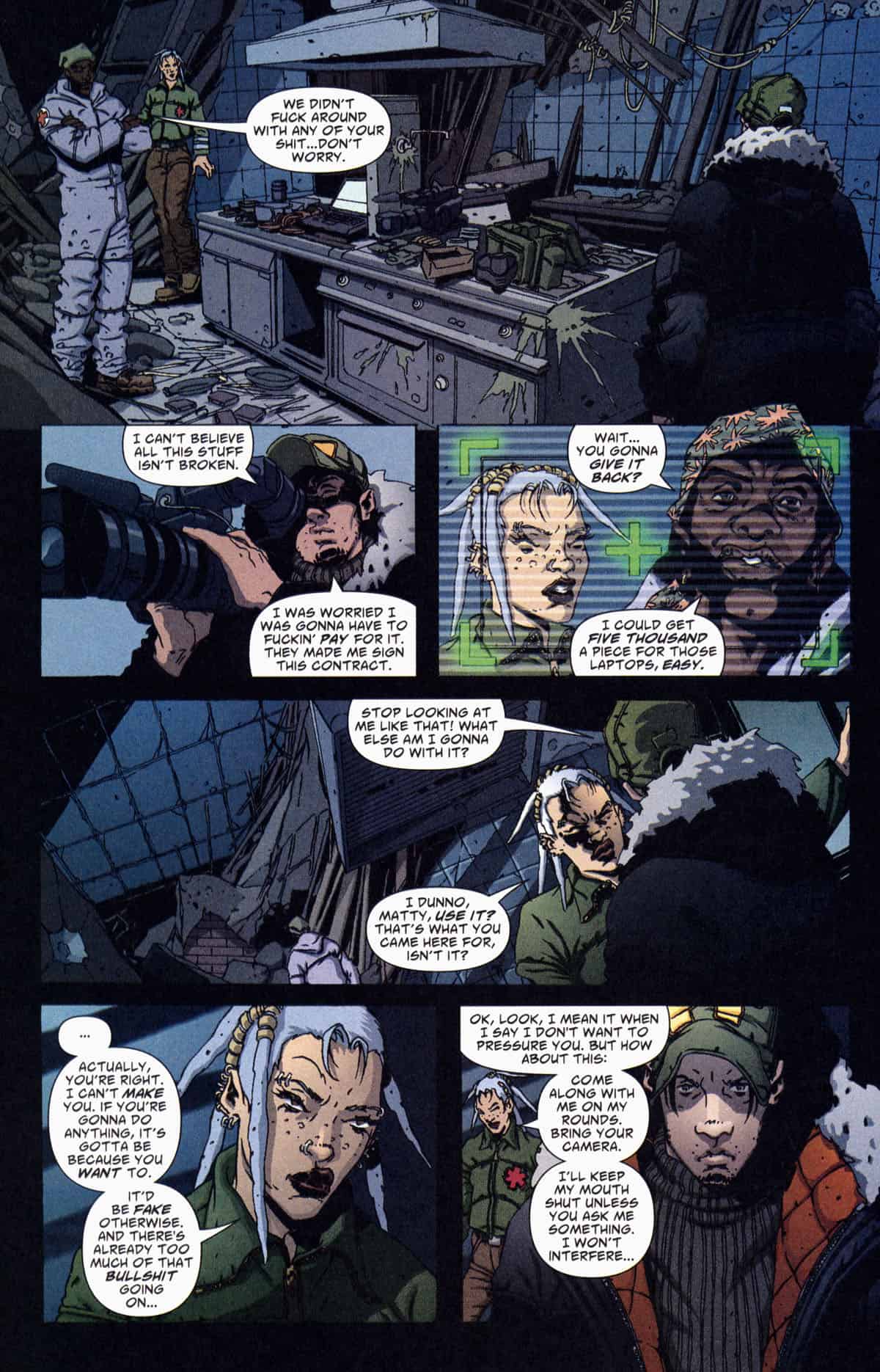
DMZ #2
Liberty News reaches out to Matty the next day, urging him to leave the city so they can send in a real journalist. Matty refuses. Liberty, stuck with him as their on-site reporter, gives him a heads up of an impending invasion. The United States is using Viktor’s death as an excuse to send the military back into the DMZ–something Liberty knows because they have paid informants in the Pentagon and elsewhere.
The invasion kicks off with a bombing strike from offshore submarines. Matty is swept up by a six man ground team moving through the city. His press pass is the only thing that keeps him alive. When Matty tries to take pictures along the way, the sergeant tells him what he can photograph and how he is to describe them.
The ground team happens upon Zee who is tending to wounded civilians. The sergeant, not wanting “another” harassment charge, keeps his men from harassing her. The team’s position comes under fire almost immediately. One of the men heads straight out into an intersection, daring insurgents to kill him. The sergeant spray paints “PRESS” on the back of Matty’s jacket and threatens to kill him if he doesn’t go out and bring his man back. Matty acquiesces. Zee tries to help as well. The attack on the ground team resumes. Matty flees the area, leaving the military to its own devices.
Liberty News confirms that Viktor Ferguson is dead and reports that the invasion was a success–Free States and insurgent forces along Manhattan’s coast were destroyed and the United States military successfully created a beachhead. The news network accepts Matty’s photos and grudgingly lets him stay as their embedded reporter.
The Lost Middle
Going in blind as Matty does offers the perfect opportunity for readers to get to know the DMZ. Matty and the reader are learning together. Matty’s varied experiences–from neighborhood violence to rooftop cafe to military invasion and everything in between–opens his mind to more than the propaganda he’s been fed by the media in the United States. This willingness to see beyond the extreme positions of the United States (and later the Free States) is a hallmark of the series.
Wood’s goal with DMZ was to tell the story of people caught up in the war rather than the story of the war itself. Indeed, scant details are provided about the state of the war or its history. This is the basis for a kind of neutral DMZ in Manhattan. Going on 20 years later, this setting is almost a commentary on ideological behavior in the United States. Political polarization has led to a situation where extreme voices on either side are the loudest while a middle portion, potentially swayable but also talked over, are lost in the noise.
This is essentially the situation in the DMZ, played out in the form of a war, when the series opens. The DMZ’s citizens have no voice. They’re stuck between two factions that are belligerent toward each other and largely don’t care about those who are caught in the middle. There’s no evidence from Wood’s interviews or other material that the series’ geographic set-up was intended to serve as a metaphor for political polarization. But it certainly speaks to the world we’re living in now.
Approved Messages
“On the Ground” introduces two major themes that will run through DMZ, and it isn’t at all subtle with them. The most important to how the series develops is its presentation of the media. Liberty News is unquestionably biased. Are they specifically an arm of the United States government? That isn’t in evidence yet–after all, they said their knowledge of the invasion came from paid informants rather than any official information. Their function more resembles that of FOX News during President Trump’s term in office.
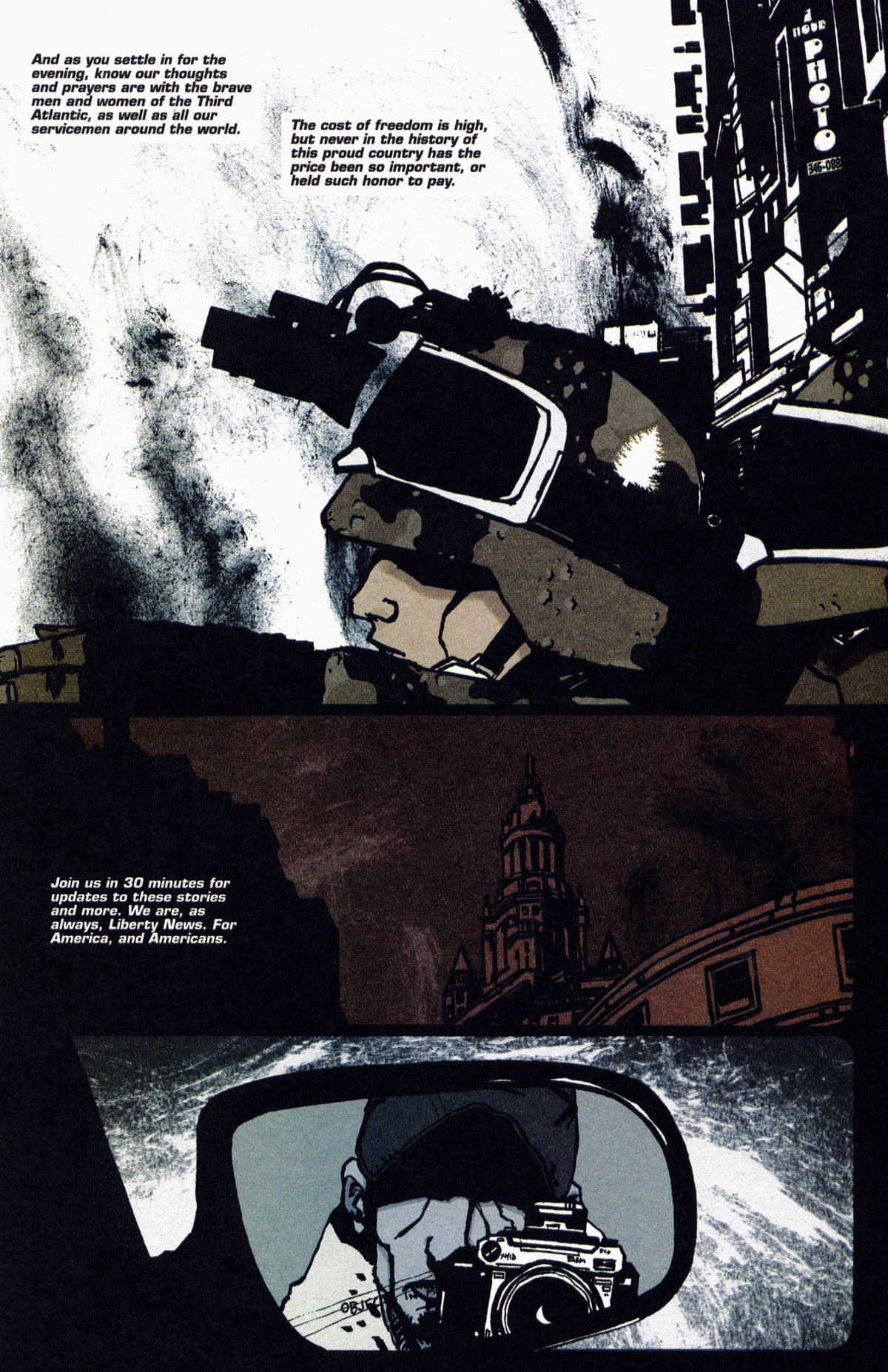
DMZ #3
Media bias was already evident in 2005, though it was nothing compared to what it is now. FOX and MSNBC, for instance, had clear points of view. But they didn’t yet feel like they existed in separate realities. At the time, Liberty News was media bias taken to what would surely be a fictional extreme. Except that it isn’t. Most FOX News personalities were slavishly loyal to Trump, extolling his political aims and all but ignoring or twisting anything negative about him. Even after President Biden took office, FOX remained supportive of Trump virtually every time the former president was in the news.
This seemed largely absurd at the time. The press in the United States, even if no one believed that it was objective, is supposed to serve a vital role in reporting the news and not being a mouthpiece for those in power. Yes, in the years that followed DMZ’s first issue, that news came more and more with opinionated commentary. But facts were still facts, more or less. Something like Liberty News, which from the start has a very flexible view of accuracy and will happily spout whatever makes the government look good, wasn’t mainstream. But DMZ proved shockingly prescient. And perhaps more shocking–it only took ten years.
The second theme “On the Ground” examines is the military, specifically the United States military (the Free States forces are handled in a different way as the series goes on). DMZ is heavily critical of the military, seldom giving it the benefit of the doubt. Beginning with DMZ #3, the military is largely depicted as unprepared, unprofessional, and on many occasions incompetent. Many soldiers are seemingly unstable as seen in the one who stands in the intersection daring insurgents to shoot him and the sergeant who threatens to kill Matty if he doesn’t go get that soldier. Unlike the ongoing examination of the media, though, this is merely the tip of the iceberg when it comes to how the series looks at the military.
Under Fire
The multiple bombings in “On the Ground” are the start of what will feel like a running joke by the end of the series. Damage from bombings in the DMZ is practically nonexistent no matter how many times it happens. This is understandable from a storytelling perspective. If Manhattan gets leveled, there wouldn’t be much of a story to tell. But it does undercut the narrative power behind the bombings.
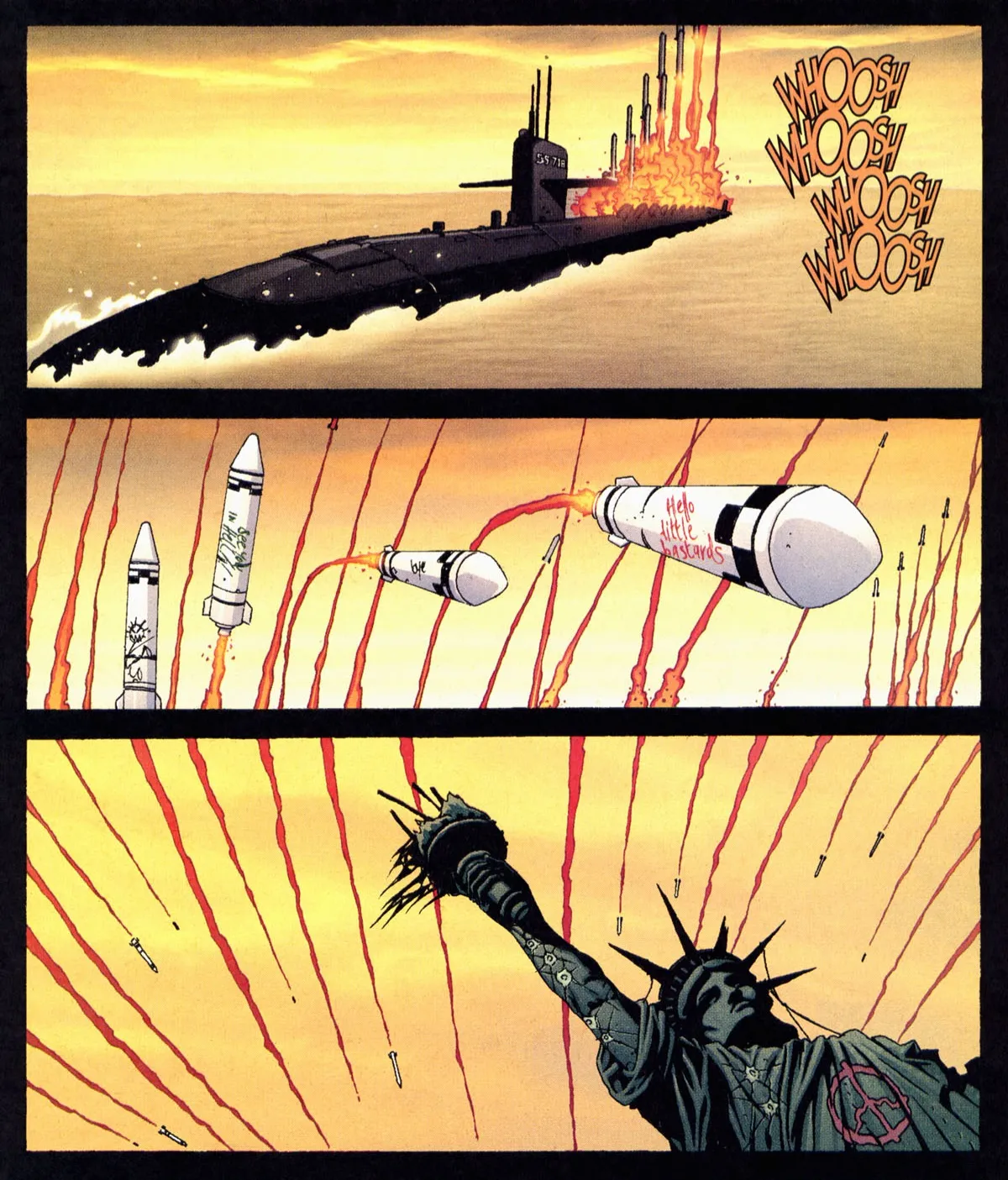
DMZ #3
This kind of bombing is reminiscent of how the United States deals with a lot of its foreign problems. And though there was a hope that once Bush was out of office it would stop, such bombings persist to this day. President Obama bombed more than Bush and Trump bombed more than Obama. And while it is unclear how many bombings have taken place under President Biden (the numbers do appear to be less than under Trump), there is no argument that the United States’ strategy of bombing foreign targets persists to this day. DMZ offers many opportunities to further consider this topic.
Despite all of this–the bombings, the military, the insurgents–the DMZ has somehow developed a culture all its own. Certainly the danger is constant. Some places like Times Square are death traps. No one really knows what goes on in the Empire State Building. And in general residents are hostile toward outsiders. But there are rooftop cafes, street vendors, art, and music. There are peaceful neighborhoods where residents pull together almost like communes.
This culture is largely where the series thrives. Characters are the series’ backbone. Sometimes they feel representative of the complicated city that they live in. Most of the broader issues that DMZ tackles aren’t explored in a vacuum, they’re explored through these characters’ eyes. And hopefully you’ll keep exploring these issues with them as this series of essays goes on and we explore how DMZ still speaks to us today.





